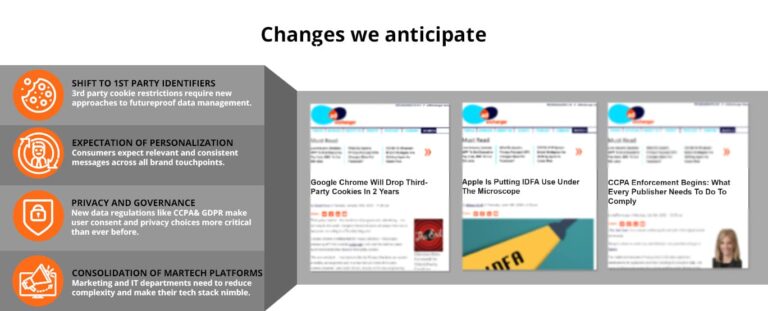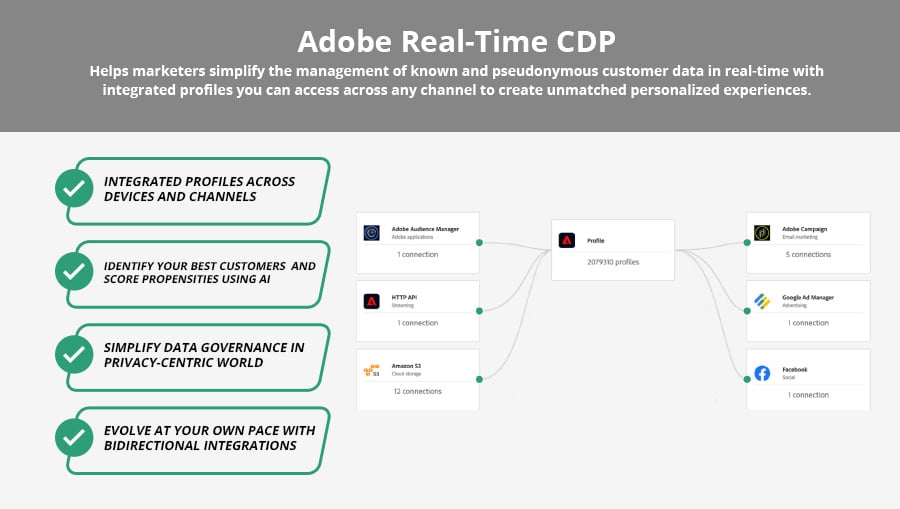
Traditionally, brands have relied on both 1st and 3rd party cookies to power their user experience and marketing activities. Some of the top brands that we have worked with pay almost equal importance to both 1st– and 3rd–party data (obtained mainly through respective cookies) to supercharge their marketing efforts.
Third-party cookies/data were mostly used by digital marketing teams to acquire and remarket customers across the internet. With Apple taking the lead in May 2017 to sunset 3rd party cookies, and Google announcing its “Privacy Sandbox” in 2019, brands are preparing for a data strategy shift. However, after Google announced its extended deadline (late 2023), brands are now questioning their own timelines and further use of third-party data.
What is our take on this?
We reckon that Google’s announcement is going to give the much-needed time to implement the strategy shift, rather than encourage brands to stay with the 3rd party strategy. They’ve given themselves another year at least to make this happen. Let us explore why!
Almost every major brand has invested in technologies like Data Management Platforms (DMP) and Demand-side Platforms (DSP), which rely on 3rd party cookies. They help segment users and show them display ads throughout the internet. In addition, these cookies are used for measuring attribution.
Despite their benefits, 3rd party cookies/data also present major drawbacks, like:
- Users increasingly see 3rd party cookies as a blatant breach of their privacy.
- 3rd party cookies seldom represent a real user and data is mostly inaccurate.
- Data misuse and irresponsible marketing is rampant with 3rd party data.
- Growth of walled gardens like Apple with more flexible privacy choices enticing users.
With increased government regulations and a shift in user mindset, it is becoming increasingly clear that 3rd party cookies are becoming outdated and slowly dying.

How can brands make this shift possible?
Even though it is somewhat restrictive, at this point, to move to a 1st party strategy, some of our customers have already planned for it. This is a long-term play and there are many impactful benefits to making the shift. Below are a few of these:
- 1st party data is far more accurate and represents a closer model of end-users.
- With user consent, customer trust will build up and positively impact customer retention.
- In the long term, due to scaling, moving away from wasteful marketing will lead to significant savings.
- It’s much easier for brands to share data with a handful of trusted partners and provide meaningful customer engagements.
These pros will not be seen overnight and require organizations and marketing teams to adapt and implement changes in technology and culture first. Technology and related processes are vital to such a transformation.
What are the key technologies at play?
Each marketing technology stack determines how this 1st party shift will become a reality. Today, we often see disparate point solutions, loosely integrated, powering these experiences. Most of the time, these solutions rely on 3rd-party data to reach or intervene in customer journeys. Here are the technologies we recommend every brand to consider:
- Customer Data Platforms (CDPs): A CDP is a 1st party version of a DMP that we discussed above. A CDP seamlessly combines 1st party data to conjure up an omnichannel view of the customer. It enables data and segment sharing based on hashed durable identifiers like email and phone numbers. Customer Data Platforms operationalize privacy and cater to simple view/deletion requests. Adobe Real-Time CDP and Salesforce CDP are some of the offerings from market leaders in Digital Experience Platforms.
- Scalable Robust Data Lakes: A data lake is a vast store of seldom-related data that provides low storage costs and virtually unlimited storage for big data. Such data lakes form the backend of technologies like CDPs and Analytics. Powerful query capabilities allow organizations to gain intelligence on segments and their cross-channel actions.
- Consent Management Systems: With privacy gaining prominence like never before, user choices must be respected. Many governments are enacting complex laws that will result in significant impacts on brands’ processes and finances. Consent Management Systems are imperative to cater to these and seamlessly integrate with solutions like CDP and analytics.
- Systems with open standards: This one is not easy at all! The components of the marketing stack should be open, to be easily integrated with custom solutions. Also, there should be a watchdog to centralize and standardize the data to promote extreme interoperability between the stack and across organizational boundaries.
- Apps built with open APIs: Leading digital experience platforms like Adobe are opening up their marketing clouds with APIs, fostering innovation. Here, one can easily draw parallels to the initial days of the Google Play Store or Apple App Store. These plug-and-play apps are game-changers because they completely democratize your marketing teams (zero IT dependence). NextRow is building an automated cross-solution validation solution called “Predictive” on Adobe’s platform. “Predictive” greatly helps to bridge the gap between business analysts and implementation developers.
Technology Spotlight
Leading marketing cloud providers (Digital Experience Platforms) like Adobe are emphasizing brands to leverage their 1st party data at scale. Adobe’s offerings like Real-time CDP with features like private device graph and segment sharing enable brands to build real-time customer profiles and activate audiences across channels. This is all done by integrating durable identifiers like phone numbers and emails with pseudonyms or 1st party cookie ids. You can easily leverage Adobe’s platform-level services to accomplish more tasks like big data querying, cataloging, and AI on top of Adobe Real-time CDP.

Way Forward
We envision the customer experience industry going through a cycle of positive disruption, putting users and their choices at the center of responsible marketing. Technology planning, implementation, and change management are clear ways to stay ahead of the game!
About NextRow
NextRow Digital is an Adobe Silver Partner and an expert in implementing Adobe technologies. We have the right skillsets and processes to support your complex needs ranging from IT teams to marketers. Grow your business with the help of RT-CDP experts at NextRow!
To learn more about our Adobe Experience Platform offerings, visit our Adobe Platform page
To learn more about our CDP offerings, visit our RTCDP page.
To learn how NextRow can help with RT-CDP assessments, planning and integrations, contact us at
Get In Touch
Driving business growth by transforming challenges into opportunities with innovative, tailored solutions that deliver measurable results.

